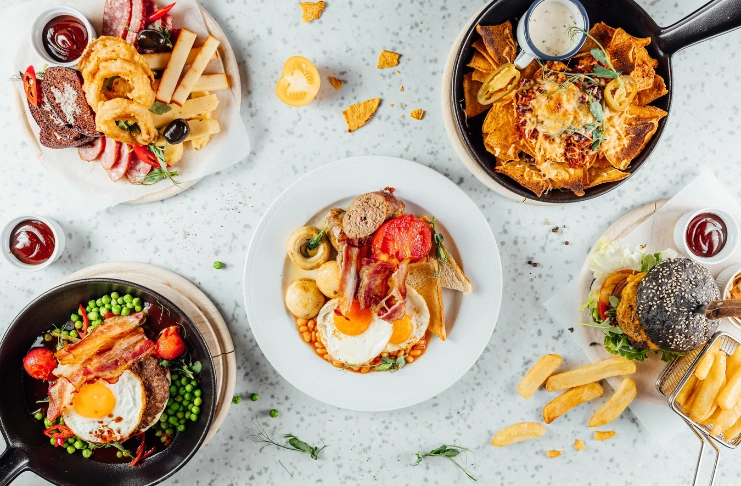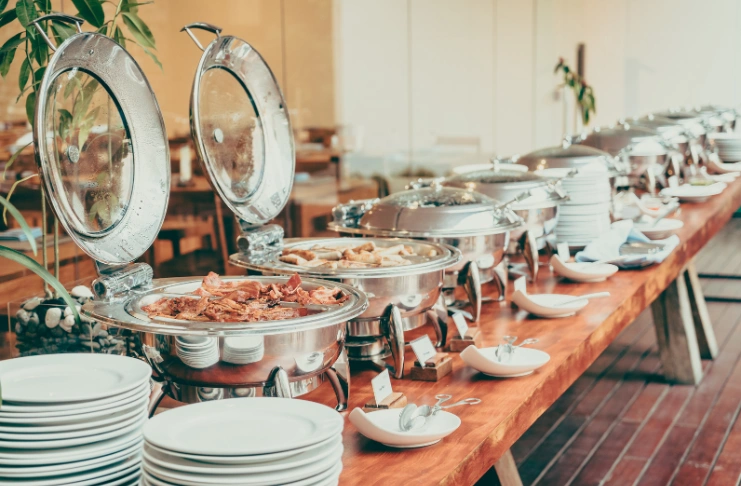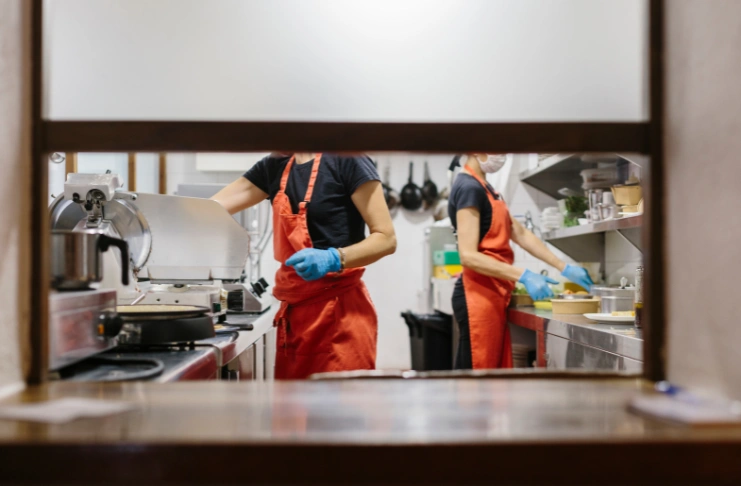Picture this: A family of four walks into your restaurant on a busy Saturday evening. The parents are tired from a long week, the kids are hungry and restless, and everyone wants something different. As they settle in at your all-you-can-eat buffet, you watch them fill their plates with various food items —repeatedly. The father returns for a third helping of prime rib, the mother samples every seafood option, the teenager piles on pasta after pasta, and the youngest constructs ice cream towers that would make an architect proud.
Sounds like a restaurateur’s nightmare? It certainly can be. But it doesn’t have to be.
Running an unlimited food restaurant—commonly known as an all-you-can-eat (AYCE) buffet—can be a high-risk, high-reward venture. While the format draws large crowds seeking value for money, ensuring profitability amidst rising costs requires a smart, well-executed strategy. The truth is, successful buffet operators aren’t just feeding hungry customers—they’re practicing a fascinating form of behavioral economics and food psychology. So what’s exactly their secret?
Is it simply charging enough to cover even the most voracious appetites? Is it cutting corners on ingredient quality? Or is there something more nuanced happening behind those steam tables and sneeze guards?
In this deep dive, we’ll explore the comprehensive strategies behind profitable unlimited food restaurants—from clever pricing structures and strategic food cost control to the subtle psychological cues that influence eating habits. Whether you’re a restaurant owner considering the buffet model, a foodie curious about the business side of your favorite weekend spot, or just someone who’s wondered “How do they make money when that guy at table seven is on his fifth plate?”, this guide will satisfy your curiosity.
Let’s dig in and uncover how the all-you-can-eat model can be engineered for success in today’s competitive restaurant landscape.
Understanding the Unlimited Food Business Model

The all-you-can-eat model offers a fixed price for unlimited servings—a seemingly counterintuitive approach that’s nonetheless survived decades of dining trends. Success in this space hinges on balancing high customer volume with rigorous operational efficiency. While most restaurants calculate profitability per dish, buffet economics works on averages and probabilities, betting that most diners will consume food worth less than what they’ve paid to enter.
According to IBISWorld, the buffet restaurant market in the U.S. alone was valued at $5 billion, showing that demand remains strong despite increasing food costs and changing dining trends. This resilience speaks to the enduring appeal of the format—customers appreciate the variety, immediacy, and sense of value, even as their overall dining habits evolve. The pandemic temporarily disrupted self-service concepts, but the segment has shown remarkable adaptability, with many operations implementing served buffets or redesigning their service approach.
What makes the unlimited food model particularly fascinating is its psychological component. Buffet operators understand human behavior—the initial excitement that leads to overfilled plates, followed by the natural limitation of stomach capacity. They design layouts, portion sizes, and food presentations to subtly influence consumption patterns. The most successful operations recognize they’re not just selling food; they’re selling an experience of abundance and choice within carefully engineered constraints.
From a business perspective, all-you-can-eat restaurants represent a masterclass in operational efficiency. Unlike traditional restaurants that must prepare individual dishes to order, buffets benefit from economies of scale in food preparation, reduced kitchen staff requirements, and predictable inventory needs. This streamlined approach allows them to serve significantly more customers per hour than table-service establishments—a critical factor in their profit equation. The model is particularly effective for capturing high-traffic periods like lunch rushes or weekend brunches, where turning tables quickly translates directly to bottom-line results.
The Psychology Behind Buffets

Buffets bank on consumer psychology in ways that might surprise even the savviest diners. Most customers eat far less than they imagine they will, creating a natural cost buffer for operators. The disconnect between our eyes and stomachs creates the perfect profit opportunity: we’re drawn in by the visual abundance and variety, believing we’ll consume enormous quantities, but biological limitations invariably kick in. A 2011 study by Cornell University showed that this visual abundance often leads to food overestimation but significantly lower actual consumption—most customers consume only 2-3 full plates worth of food, regardless of how long they stay.
The psychology extends beyond mere quantity. Buffet operators strategically arrange food stations to guide customer behavior—placing less expensive, filling items like bread, pasta, and rice at the beginning of the line where plates are emptiest and appetites are strongest. Premium items like seafood and carved meats typically appear later in the sequence, when space on plates is limited. The constant visibility of other diners also creates subtle social pressure; most people unconsciously moderate their consumption to avoid appearing gluttonous, even in an all-you-can-eat environment.
Temperature and lighting choices further influence eating behaviors. Warmer lighting and background music encourage faster eating and quicker table turnover, while the strategic use of mirrors can make food displays appear more abundant than they actually are. Even plate size matters—research shows that smaller plates lead diners to serve themselves less food while still feeling satisfied with their portion. Some buffets have reduced their standard plate diameter by an inch or more over the years, cutting food waste without customers noticing or feeling deprived.
Perhaps most fascinating is the psychology of value perception. Buffet patrons often judge their experience not by how much they actually ate, but by the variety they sampled and the theoretical value they received. A diner who takes small portions of fifteen different dishes may consume less food than someone eating large portions of three items, yet the first customer typically reports higher satisfaction and perceived value. Smart operators capitalize on this by offering an extensive selection of inexpensive items with different flavor profiles rather than large quantities of premium ingredients—creating the impression of luxury through variety rather than through costly ingredients.
Key Challenges in Buffet Operations

Operating an AYCE restaurant in the U.S. market comes with unique challenges that must be addressed to sustain profitability:
- Food Wastage: Guests serving themselves often take more than they can eat, resulting in excessive waste.
- Cost Per Diner Variability: While many guests consume moderately, a few heavy eaters can skew average food costs.
- Labor-Intensive Setup: Staffing for food preparation, tray replenishment, cleaning, and guest assistance can inflate payroll costs.
- Health Regulations: Buffets in the U.S. must adhere to strict health codes, including sneeze guards, temperature monitoring, and allergen labeling.
- Inconsistent Quality: Keeping food fresh and appealing in a self-service model requires constant attention and training.
These factors make cost control in buffet restaurants not just beneficial—but essential for long-term success in a competitive, regulated market.
Cost Control in Buffet Restaurants: Proven Tactics

Effectively managing expenses without compromising on variety or quality is key to profitability. These tactics are widely used across successful U.S. buffet chains:
a. Menu Engineering for Buffets
Menu engineering in a buffet setup goes beyond just deciding what dishes to serve—it involves strategic layout planning to influence guest behavior. Place high-margin, low-cost foods such as pasta, rice, and bread at the beginning of the buffet line. These filler items quickly make guests feel full, reducing the likelihood of them overloading on costlier items like seafood, steak, or specialty meats. Place premium proteins further down the line or at separate live counters. Also, rotate themes and seasonal specials to keep the menu dynamic while sticking to profitable staples. This approach ensures that your food cost per guest stays within target margins while still offering variety and perceived value.
b. Smart Portioning Tools
Portion control is subtle but incredibly effective in buffet settings. Use smaller plates to naturally limit how much food guests can take per trip—research shows this reduces over-serving without affecting satisfaction. Narrow, shallow serving utensils like small ladles or tongs also help manage portion sizes. Moderate tray sizes discourage piling food high. Chains like Golden Corral have mastered these techniques, combining plate size, tray spacing, and utensil choice to reduce food waste and keep costs in check, all while maintaining a sense of abundance.
c. Limited High-Cost Items
To offer variety without breaking the bank, reserve expensive items—like BBQ ribs, grilled shrimp, or prime rib—for special areas or limited time slots. These can be served at a live counter by a staff member or only during peak hours, like weekend dinners. This controlled access to premium dishes creates excitement and perceived exclusivity, boosting customer satisfaction while limiting overconsumption. For example, guests may only get one portion of prime rib per visit, which keeps costs predictable but still delivers that “value for money” feeling.
d. Ingredient Optimization
Smart ingredient use is one of the most overlooked cost-saving methods. Cross-utilize versatile ingredients across multiple dishes to streamline prep and reduce spoilage. A single protein, like rotisserie chicken, can be used in chicken salad, wraps, soups, and pasta. Vegetables can be repurposed into side dishes, stir-fries, and salad bar toppings. This kind of menu synergy minimizes the number of unique items you need to stock, simplifies staff training, and increases efficiency across the kitchen—especially important in high-volume buffet operations.
e. Real-Time Inventory Tracking
Inventory tech plays a critical role in keeping buffet operations profitable. Platforms like Restroworks offer real-time tracking of ingredient usage, waste levels, and reorder alerts. These systems help forecast demand more accurately, reducing over-purchasing and spoilage. You can also monitor which items are consistently underperforming and adjust accordingly. Some tools even integrate with your POS system to track consumption trends and predict inventory needs based on weather, day of the week, or local events. This data-driven approach prevents costly surprises and supports smooth, lean operations.
These measures support sustainable operations and maintain a consistent guest experience.
Pricing Strategy for All-You-Can-Eat Restaurants

A successful AYCE pricing strategy in the U.S. must balance affordability, perceived value, and operating costs.
a. Tiered Pricing
Tiered pricing allows you to optimize revenue based on customer behavior patterns across different times and days. Weekday lunch crowds, often made up of office workers or retirees, typically prefer quick and affordable meals—so a lower lunch buffet price attracts them while keeping costs manageable due to lighter eating habits. On the other hand, weekend dinners are usually reserved for families or groups celebrating occasions, which means they are more willing to spend. Charging a premium for these time slots maximizes revenue without changing the menu. This strategy also improves traffic during slower periods and ensures better resource allocation across the week by aligning with customer preferences.
Example:
- Weekday lunch: $12.99
- Weekday dinner: $16.99
- Weekend dinner: $19.99
b. Dynamic Pricing
Dynamic pricing involves adjusting buffet rates based on demand trends, special events, or seasons. For example, during major holidays like Thanksgiving, Christmas, or Memorial Day weekend, customer traffic spikes due to family gatherings or time off work. You can slightly raise buffet prices during these periods or offer exclusive menu items (e.g., turkey carving station, seasonal desserts) to justify the price bump. It’s also useful during local festivals or sports events when demand is naturally higher. Dynamic pricing enables you to increase average revenue per cover while managing higher costs associated with these peak times.
Be transparent with price changes and emphasize the value of holiday-specific offerings to avoid customer dissatisfaction.
c. Kids and Senior Discounts
Buffet dining is particularly attractive to families and older adults, both of whom represent a large portion of the AYCE customer base. Since children and seniors typically eat less than average adults, offering them discounted rates increases overall foot traffic without significantly impacting food costs. For families, this discount becomes a strong incentive to choose your restaurant over à la carte options. For seniors, especially during weekday lunch hours, it builds loyalty and creates a steady customer flow.
Example Discount Model:
- Kids under 5: Free
- Kids aged 6–10: 50% off
- Seniors 60+: 20% off weekdays before 5 PM
d. Bundle Add-Ons
Offering premium add-ons can significantly boost average check size. These bundles give guests the option to enhance their experience without overhauling your base buffet pricing. For instance, you can offer:
- Unlimited soft drinks or fresh juices
- A premium dessert bar featuring cakes, chocolate fountains, and sundaes
- Access to an extended salad bar with gourmet toppings
- Alcohol bundles like bottomless beer, wine, or cocktails
Since not every guest will opt in, the additional cost remains controlled, but for those who do, the added margin helps your bottom line. Highlight these bundles with eye-catching signage and put them on your digital menus.
e. Psychological Pricing
Psychological pricing is a time-tested technique in hospitality that leverages human perception. Rather than pricing your buffet at round numbers like $20, set it at $19.95 or $14.99. This pricing feels more affordable, even if the actual difference is negligible. The “.99” and “.95” endings subtly convince diners they are getting a deal, which can influence purchase decisions—especially in competitive markets.
You can also experiment with “anchor pricing” by showing a higher-priced item (like a $25 buffet with premium add-ons) next to your regular $19.99 buffet to make the standard option feel like a better value.
How to Make a Profit in an All-You-Can-Eat Restaurant

Profit in AYCE restaurants relies on guest volume, cost control, and operational precision.
a. Monitor Cost Per Cover (CPC)
Cost Per Cover (CPC) refers to the total cost of food and beverages served to a single guest. In an all-you-can-eat setup, where diners pay a fixed price regardless of how much they eat, keeping this cost in check is crucial for profitability.
In the U.S., restaurants generally aim for food costs to be 28–30% of the selling price. So, if your buffet is priced at $20, the total food cost per guest should ideally not exceed $5.60–$6.40.
To maintain this ratio:
- Promote low-cost, high-satiety items like pasta, rice, and bread.
- Offer expensive proteins in smaller portions or during time-limited windows.
- Track and analyze food waste to refine portion sizes and menu offerings.
Routinely calculate CPC during both peak and off-peak hours to catch fluctuations early and adjust inventory or pricing accordingly.
b. Cross-Utilization of Staff
Labor is one of the largest operational expenses in a buffet-style restaurant. Cross-utilizing employees for multiple roles helps reduce the total number of staff required without compromising service quality.
Train staff to:
- Greet and seat guests during peak entry hours.
- Replenish buffet trays efficiently between rushes.
- Cash out customers or assist with bussing during quieter times.
This dynamic staffing model improves flexibility, lowers payroll costs, and ensures employees stay engaged and productive throughout their shifts.
A floor staffer could greet guests at opening time, then shift to clearing tables and refilling water during service, and help with end-of-day cleanup.
c. Minimize Table Turnover Time
Increasing the number of guests served during each mealtime window boosts overall revenue without needing to increase capacity. The key is to encourage faster table turnover subtly, without making diners feel rushed or unwelcome.
Tactics include:
- Upright seating: Chairs with less padding and straighter backs discourage lingering.
- Bright, energizing lighting: Unlike dim, cozy lighting in fine dining, brighter lighting keeps the pace upbeat.
- Quick table clearing: Clearing empty plates promptly signals that the dining cycle is complete and makes the space look tidy for new guests.
- Streamlined buffet layout: Reduce bottlenecks so guests can serve themselves quickly and return to their tables faster.
Avoid loud or harsh cues that may feel pushy—subtle environmental design can do the trick effectively.
d. Leverage Technology
Modern technology makes it easier to control costs, forecast demand, and make data-driven decisions.
- AI-powered forecasting tools to analyze historical data to:
- Predict guest volumes by day and hour.
- Help managers schedule the right number of staff at the right time.
- Avoid overstaffing during slow periods and understaffing during rushes.
- Point-of-Sale (POS) systems provide real-time data on:
- Best- and worst-performing buffet items.
- Average revenue per guest.
- High-waste dishes that need to be re-evaluated.
- Digital guest feedback tools can identify:
- Satisfaction levels with specific dishes.
- Bottlenecks in service.
- Patterns that may be affecting customer retention or upsell success.
Integrating these systems helps you tighten operations, reduce excess, and make informed improvements without guesswork.
These strategies ensure consistent profitability even when offering abundant food.
Popular Dishes That Drive Profits

U.S. buffet restaurants thrive on comfort food and crowd-pleasers that are affordable yet filling. Examples include:
- Mac & Cheese: A staple in American buffets—cheap, delicious, and filling.
- Fried Chicken: Flavorful and budget-friendly when portioned smartly.
- Mashed Potatoes and Gravy: High perceived value, low cost.
- Salad Bars: Visually appealing and cost-effective, especially with in-house dressings.
- Pizza and Breadsticks: Great filler items with low ingredient costs.
- Rice and Pasta Dishes: Easily adapted to multiple cuisines (Italian, Asian, etc.)
These dishes keep food costs low while satisfying a broad audience.
Optimizing Food Layout and Flow

Layout matters. How food is presented influences both the guest experience and operational efficiency:
- Start with fillers: Salads, breads, and pasta are first in line.
- Space out premium items: Use corners or end-of-line sections.
- Live stations: Use staff to serve pricier items like steaks or seafood.
- Clear signage: Include nutrition info, allergens, and food labels.
This setup subtly guides guest choices while reducing the cost per plate.
Embrace Seasonal and Local Sourcing

Buy produce and meat from local suppliers when possible. This cuts logistics costs and improves freshness.
INDUSTRY INSIGHT
| A Nielsen report highlighted that approximately 48% of U.S. consumers were likely to change their purchasing habits to meet environmental standards, reflecting a growing awareness and concern for sustainability in general consumer behavior. According to NielsenIQ’s sustainability insights, 78% of consumers consider responsible sourcing as one of the most important sustainability claims, underscoring the value placed on how products are sourced. |
Partnering with local farms and markets can also create community goodwill and help build loyalty.
Hygiene and Safety Compliance

Buffets in the U.S. are highly scrutinized for food safety. A single violation can result in fines, closures, or media backlash. Some important tips regarding food handling include :
- Follow the FDA’s Food Code.
- Install sneeze guards and maintain hot/cold holding temps.
- Log temps regularly and train staff on cross-contamination.
- Keep sanitizer stations accessible for guests.
Investing in hygiene builds trust and protects your brand.
Staff Training for Buffet Efficiency

Trained staff = fewer errors, less waste, and happier guests. Focus areas are:
- Proper food rotation (FIFO method)
- Tray replenishment techniques
- Communication with guests
- Monitoring portion control at live counters
Offer ongoing training and reward systems to keep morale high.
Marketing Strategies to Boost Buffet Traffic

For all-you-can-eat buffets, steady footfall is essential to cover costs and maintain profit margins. Unlike à la carte restaurants, where upselling adds revenue per guest, buffets thrive on volume, repeat visits, and predictable dining patterns. These marketing strategies are proven to fuel growth in the U.S. market:
a. Loyalty Programs
Why it works: Buffets attract regulars—families, retirees, lunch crowds—who appreciate value. A loyalty program incentivizes repeat visits and makes guests feel rewarded for coming back. Implement by:
- Using digital loyalty platforms to track visits and assign points.
- Offering rewards like a free meal after seven visits, birthday bonuses, or priority seating on weekends.
- Including surprise rewards like bonus points on slow weekdays to boost traffic on those days.
Keep the system simple and visual (e.g., digital punch cards), and let customers track progress on their phones.
b. Social Media & Local Ads
Why it works: Most buffet-goers search locally when deciding where to eat, and social media is a powerful way to catch them in the moment. Some strategies to use:
- Run Facebook and Instagram ads targeting specific zip codes or demographics (e.g., families, seniors).
- Highlight weekend buffet spreads, themed nights, and chef specials using Instagram Reels and Facebook Stories.
- Optimize your Google Business Profile with accurate hours, recent photos, and positive reviews to rank higher in local searches.
Some content ideas can be:
- Behind-the-scenes buffet prep
- Daily or weekly “chef’s pick” videos
- Customer testimonials or plate-stacking challenges
Encourage customers to tag your restaurant when they post photos—offer small incentives like a free drink or dessert.
c. Themed Nights
Why it works: Themed nights create excitement, drive mid-week traffic, and give people a reason to return regularly—even if they’ve been recently. Popular themes in the U.S. are:
- Taco Tuesdays: Serve a mini taco station with build-your-own toppings.
- Seafood Fridays: Spotlight shrimp, crab legs, fish fry, or sushi rolls.
- Kids Eat Free Wednesdays: With the purchase of an adult meal, a child under 12 eats free.
- International Nights: Rotate cuisines, such as Italian, Indian, Chinese, Southern BBQ, etc.
- Holiday Buffets: Easter, Thanksgiving, July 4th, and New Year’s specials.
Some key tips for execution are:
- Promote themed nights heavily on social media and via in-store signage.
- Encourage group reservations with call-to-action phrases like “Book your table now!”
Use live music or entertainers on select theme nights to elevate the experience and increase dwell time.
d. Community Collaborations
Why it works: Local partnerships build trust, create word-of-mouth buzz, and position your buffet as part of the neighborhood fabric. Some ideas for partnership:
- Schools & churches: Host fundraising nights and donate a portion of sales to the organization.
- Youth sports teams: Offer post-game team meals at a discount.
- Senior centers: Promote weekday lunch specials and transportation-friendly offers.
- Local businesses: Create co-branded promotions (e.g., “Show your gym card and get 10% off lunch”).
Some key benefits of community collaborations are:
- Builds long-term brand loyalty.
- Increases bookings for group events, birthday parties, and club gatherings.
- Encourages larger party sizes, which is ideal for buffet efficiency.
Provide community partners with flyers, social graphics, or even discount codes they can share with their members to drive referrals.
A strong local presence helps build a loyal customer base.
Technology Integration

Tech empowers modern buffet operations:
- Digital Menus and QR Ordering: Reduces staff load.
- Inventory Software: Track ingredient usage and waste.
- Analytics Dashboards: Identify top-selling and underperforming items.
Among operators that have invested more in technology over the last two to three years, 69% of operators say it made their operations more efficient and productive. In a recent National Restaurant Association (NRA) survey, 55% of restaurant operators said they’re planning tech investments to improve service.
Real-World Case Study: Golden Corral
Golden Corral exemplifies how to profit from an unlimited food restaurant strategy in the U.S. They’ve weathered economic shifts by adopting technology, optimizing pricing, and focusing on family-friendly service. Their use of loyalty programs, data analytics, and food safety measures continues to drive foot traffic.
Conclusion
An effective unlimited food restaurant strategy blends guest satisfaction with operational excellence—a delicate balancing act that requires equal parts hospitality and business savvy. By implementing rigorous cost control measures, optimizing pricing strategies, and continuously refining operations, restaurateurs can transform the seemingly contradictory all-you-can-eat concept into thriving, profitable enterprises. The buffet model isn’t just surviving in today’s dining landscape—with the right approach, it’s flourishing.
Remember that family of four we met in the introduction? Their experience represents both the challenge and opportunity of the buffet model. While the father’s multiple trips for prime rib might initially appear alarming from a cost perspective, a well-designed buffet has accounted for these outliers. For every power-eater enjoying their third helping of premium items, there are typically several lighter eaters who gravitate toward less expensive offerings. The mother sampling seafood likely took small portions to try everything rather than heaping quantities. The teenager loading up on pasta is primarily consuming one of your lowest-cost, highest-margin items. And that ice cream tower? The food cost is minimal compared to the memorable experience being created.
The most successful buffet operators understand that they’re not selling unlimited food—they’re selling the perception of abundance, the luxury of choice, and the freedom from decision fatigue that comes with traditional menu ordering. They’ve learned to use psychology, strategic food placement, portion control through serving utensils and plate sizes, and careful ingredient selection to create experiences that feel extravagant to customers while maintaining healthy profit margins. The art lies in making guests feel they’ve received tremendous value while carefully managing the actual costs behind the scenes.
As we move further into the 2020s, adaptation remains key to buffet success. Today’s operators are embracing technological solutions for inventory management, implementing reservation systems to optimize seating, and using data analytics to predict busy periods and food consumption patterns. Many are incorporating chef-attended stations that combine the appeal of freshly prepared food with portion control to cater to various dietary preferences. Others are experimenting with hybrid models—offering unlimited options for certain categories while charging premium add-ons for specialty items.
What hasn’t changed is the fundamental appeal of the all-you-can-eat concept: the promise of abundance without boundaries, the satisfaction of choice, and the value proposition that continues to draw crowds decades after the format first gained popularity. By combining time-tested psychological principles with modern business practices and technological innovations, today’s buffet operators can continue to satisfy both customer appetites and bottom-line requirements—proving that in the restaurant industry, sometimes the most counterintuitive business models can be the most enduringly successful.
Frequently Asked Questions
1. How does unlimited food work?
An unlimited food restaurant charges a fixed price for guests to serve themselves and eat as much as they want, typically in a self-service buffet format.
2. How do I prepare for unlimited food?
Guests can prepare by arriving hungry, pacing themselves, and sampling small portions to try a variety of dishes without overloading on one item.
3. Does buffet mean unlimited food?
Most buffets in the U.S. offer unlimited food for a flat fee, but some high-end or specialty buffets may impose limits on premium items.
4. How to beat an all-you-can-eat buffet?
From a diner’s perspective, pacing your meal, starting with proteins, and skipping fillers can maximize value, but buffets are designed to balance consumption patterns profitably.
5. How are all-you-can-eat buffets profitable?
Buffets profit through volume sales, low-cost filler foods, portion control tactics, cross-utilized ingredients, and strategic food placement to limit high-cost item consumption.
6. How much profit can you make owning a restaurant?
In the U.S., restaurant profit margins typically range from 3% to 10%, but efficient buffet models can hit 10%–15% when optimized correctly.
7. What type of restaurants make the most profit?
Fast-casual, pizza, and buffet-style restaurants often see high margins due to scalable menus, bulk purchasing, and efficient service models.
8. How do you make all-you-can-eat worth it?
Restaurants make it worthwhile by pricing based on average consumption, using high-margin menu items, and minimizing food waste through layout and portioning strategies.
9. What is cost control in a restaurant?
Cost control involves tracking and managing food, labor, and overhead expenses to maintain profitability without compromising quality.
10. How is buffet costing done?
Buffet costing is calculated by estimating the average food cost per guest and ensuring it stays below a set percentage (typically 28–32%) of the buffet price.
11. How to reduce costs in a restaurant?
Reduce costs by optimizing inventory, cross-training staff, minimizing waste, negotiating supplier contracts, and using seasonal or local ingredients.
12. How does buffet pricing work?
Buffet pricing factors in average consumption, ingredient costs, competition, and perceived value, often using tiered pricing for different days or times.
13. What is the best pricing strategy for a restaurant?
The best strategy combines value perception, psychological pricing (e.g., $14.99), tiered pricing, and bundling to maximize revenue while staying competitive.
14. How do I set the price for a buffet?
Calculate your cost per diner (CPP), target your desired food cost percentage (e.g., 30%), and adjust based on competition, demand, and dining trends.
15. How to calculate buffet price?
Use the formula: Buffet Price = (Estimated Food Cost per Guest) / (Target Food Cost%) — for example, $6 food cost ÷ 0.30 = $20 buffet price.





